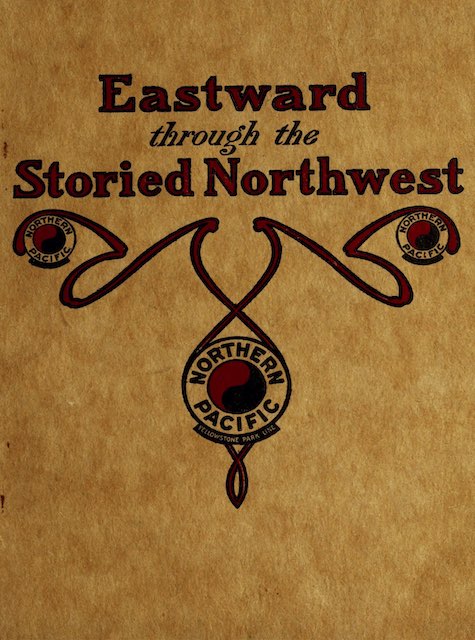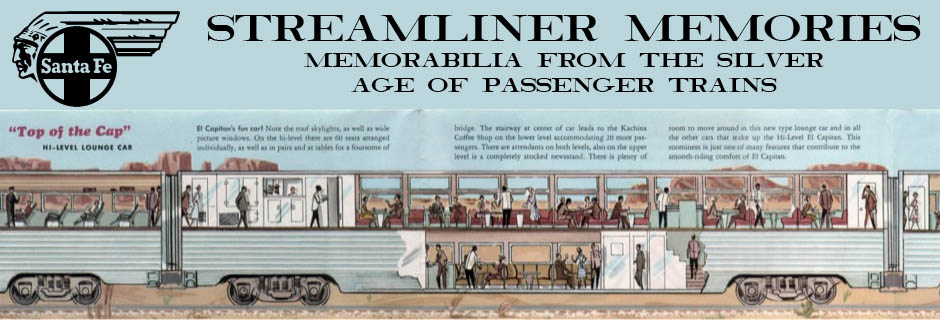We’ve previously seen booklets of this title dated 1909 1915, and 1929. This one is from 1906, but wasn’t the first in the series as I’ve seen references to earlier editions in some of NP’s other publications. The booklet, which NP sold for a nominal 6¢ (presumably to cover postage; 6¢ in 1906 was a little more than $2 in today’s money) was designed to entice people in California to use the Northern Pacific on their eastward journeys, which required that they first take the Southern Pacific to Portland.
 Click image to download an 25.6-MB PDF of this 60-page booklet from archive.org. Although I’ve edited the covers to restore their original colors, if you have a slow internet connection or are short on disc space, you should download archive.org’s version as the PDF is smaller than mine.
Click image to download an 25.6-MB PDF of this 60-page booklet from archive.org. Although I’ve edited the covers to restore their original colors, if you have a slow internet connection or are short on disc space, you should download archive.org’s version as the PDF is smaller than mine.
As was typical for early 20th century advertising, the booklet is a travelogue describing the wonders people would see and side trips they could take on such a journey. The first 6 pages describe the Southern Pacific’s coast route, while the next 9 focus on the Shasta route. Northern Pacific doesn’t begin until page 20, including a ferry ride across the Columbia River as the railroad bridge wouldn’t open until 1908. The booklet reaches St. Paul on page 42, but Yellowstone was given its own four-page chapter beginning on page 43.
The text is credited to Olin D. Wheeler (1852-1925), an engineer and historian who led Northern Pacific’s advertising department from 1892 to 1908. A civil engineer by training, Wheeler helped survey the Rocky Mountains for John Wesley Powell’s United States Geological Survey. He moved to St. Paul in 1882. After starting work for NP, he wrote the Wonderland series and other NP publications as well as a two-volume history of the Lewis & Clark Expedition, regarded as the first significant historical work on that event. Both volumes as well as many other Wheeler publications are downloadable from archive.org.
Pages 48 and 49 present timetables for SP’s Shasta route trains and eastbound timetables for the North Coast Limited and two other NP transcontinentals listed as trains 4 and 6. These trains are unnamed in the booklet, which was just as well as most of NP’s train names at that time were pretty boring. According to timetables, NP called train #4 the Twin Cities Express while its counterpart, #3, was the Pacific Express. Train #6 split at Billings with most of it going over the Burlington to St. Louis and both it and train #5 were called the Burlington Express. The portion of the train that went between Billings and St. Paul was called the Minnesota Local.
Pages 51 and 52 describe a number of intriguing publications available from NP, some of which are familiar, some not, and many by Olin Wheeler. These include:
- The annual Wonderland, many issues of which are available on archive.org (6¢);
- A free booklet on the North Coast Limited;
- Miniature Wonderland, which also contained a history of NP’s trademark (4¢);
- Wildflowers from Yellowstone, which included pressed specimens of a dozen actual wildflowers (50¢);
- A panoramic picture of Yellowstone produced for Northern Pacific by lithographer Henry Wells and available from the David Rumsey Collection and/or archive.org (35¢);
- NP’s annual Yellowstone Park booklet, the 1906 edition of which can be found on archive.org (free);
- A 50-page booklet on Minnesota lakes (free);
- This booklet, which cost 6¢;
- A pocketsized booklet on climbing Mount Rainier (25¢); and
- A Northern Pacific map folder (free).
